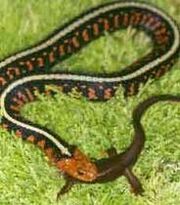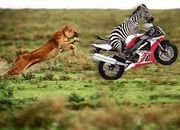No edit summary |
Tag: Visual edit |
||
| (One intermediate revision by one other user not shown) | |||
| Line 4: | Line 4: | ||
==Coevolution== |
==Coevolution== |
||
| − | <p class="MsoNormal"><span style="font-size:14.0pt;font-family:"Times New Roman"">Coevolution can be described as a close ecological relationship between two (or more) species in one species adapts to changes in the other, thereby reciprocally affecting one another’s evolution.</span></p> |
+ | <p class="MsoNormal"><span style="font-size:14.0pt;font-family:"Times New Roman"">Coevolution can be described as a close ecological relationship between two (or more) species in which one species adapts to changes in the other, thereby reciprocally affecting one another’s evolution.</span></p> |
| − | <p class="MsoNormal"><span style="font-size:14.0pt;font-family:"Times New Roman"">Coevolution is likely to occur when different species have close ecological interactions with one another such as in symbiotic relationships.<span style="mso-spacerun:yes"> </span> |
+ | <p class="MsoNormal"><span style="font-size:14.0pt;font-family:"Times New Roman"">Coevolution is likely to occur when different species have close ecological interactions with one another such as in symbiotic relationships.<span style="mso-spacerun:yes"> </span>These includes predator-prey, parasite-host and mutualism.[[File:Coevolution toxic newts|thumb|right|335 px]]</span></p> |
<p class="MsoNormal"><span style="font-size:14.0pt;font-family:"Times New Roman"">For example, through the process of natural selection, predators and their prey inherit physical traits that make them more likely to survive. According to Dawkins & Krebs (1979), this can trigger predator-prey “arms races”. As prey defense adaptations improve, counter improvements occur in predator attack adaptations and vice versa over numerous generations. This is only one example of coevolution and there are many other symbiotic partnerships that drive natural selection and therefore evolution.</span></p> |
<p class="MsoNormal"><span style="font-size:14.0pt;font-family:"Times New Roman"">For example, through the process of natural selection, predators and their prey inherit physical traits that make them more likely to survive. According to Dawkins & Krebs (1979), this can trigger predator-prey “arms races”. As prey defense adaptations improve, counter improvements occur in predator attack adaptations and vice versa over numerous generations. This is only one example of coevolution and there are many other symbiotic partnerships that drive natural selection and therefore evolution.</span></p> |
||
| Line 19: | Line 19: | ||
==Evolutionary Arms Races== |
==Evolutionary Arms Races== |
||
| − | An evolutionary arms race is an evolutionary |
+ | An evolutionary arms race is an evolutionary competition between predator/prey species. As sets of co-evolving genes develop adaptations and counter-adaptations against each other, predators and prey may often show an evolutionary pattern called escalation: as predators evolve more powerful weapons prey develop more powerful defenses against them. |
<p class="MsoNormal"><span style="font-family:"Times New Roman"">Abrams, P. A. 1986b. Is predator-prey coevolution an arms race? TREE 1:108-110.</span></p> |
<p class="MsoNormal"><span style="font-family:"Times New Roman"">Abrams, P. A. 1986b. Is predator-prey coevolution an arms race? TREE 1:108-110.</span></p> |
||
Latest revision as of 21:10, 19 October 2020

Coevolution-1

Write the first paragraph of your page here.
Coevolution
Coevolution can be described as a close ecological relationship between two (or more) species in which one species adapts to changes in the other, thereby reciprocally affecting one another’s evolution.
Coevolution is likely to occur when different species have close ecological interactions with one another such as in symbiotic relationships. These includes predator-prey, parasite-host and mutualism.

Coevolution toxic newts
For example, through the process of natural selection, predators and their prey inherit physical traits that make them more likely to survive. According to Dawkins & Krebs (1979), this can trigger predator-prey “arms races”. As prey defense adaptations improve, counter improvements occur in predator attack adaptations and vice versa over numerous generations. This is only one example of coevolution and there are many other symbiotic partnerships that drive natural selection and therefore evolution.
Dawking, R. & Krebs, J. R. (1979). Arms races between and within species. Proceedings of the Royal Society of London. B 205: p. 489-511.
Evolutionary Arms Races
An evolutionary arms race is an evolutionary competition between predator/prey species. As sets of co-evolving genes develop adaptations and counter-adaptations against each other, predators and prey may often show an evolutionary pattern called escalation: as predators evolve more powerful weapons prey develop more powerful defenses against them.
Abrams, P. A. 1986b. Is predator-prey coevolution an arms race? TREE 1:108-110.

The "lighter side" of evolutionary arms races!
An excerpt from, A Beautiful Web of Poison Extends a New Strand,
by Carl Zimmer, The Loom, June 21, 2011.
The scientific tale of the rough-skinned newt begins five decades ago, with a story about three dead hunters in Oregon. Reportedly, the bodies of the hunters were discovered around a camp fire. They showed no signs of injury, and nothing had been stolen. The only strange thing about the scene was the coffee pot. Curled up inside was a newt.
In the 1960s, a biologist named Butch Brodie got curious about the story. The newt in the coffee pot–known as the rough-skinned newt–has a dull brown back, but when it is disturbed, it bends its head backward like a contortionist to reveal an orange belly as bright as candy corn. Bright colors are common among poisonous animals. It’s a signal that says, in effect, “If you know what’s good for you, you’ll leave me alone.” Brodie wondered if the newts were toxic, too.
Toxic, it turns out, doesn’t do the newts justice. They are little death machines. The newts produce a chemical in their skin called tetrodotoxin, or TTX for short, that’s made by other poisonous animals like pufferfish. Locking onto sodium channels on the surface of neurons, TTX blocks signals in the nervous system, leading to a quick death. In fact, TTX is 10,000 times deadlier than cyanide. While we may never know for sure what killed those three Oregon hunters, we do know that a single rough-skinned newt could have easily produced enough TTX to kill them, and have plenty of poison left over to kill dozens more.
Now, if the whole idea of evolution makes you uneasy, you might react by saying, “That couldn’t possibly have evolved.” Experience has shown that this is not a wise thing to say. Brodie said something different: the most plausible explanation for a ridiculously poisonous animal is that it is locked in a coevolutionary arms race with a ridiculously well-defended predator. Another biologist mentioned to him that he’d seen garter snakes dining on rough-skinned newts, and so Brodie investigated. He discovered that garter snakes in rough-skinned newt territory have evolved peculiar shape to the receptors on their neurons that TTX would normally grab.
The coevolution of newts and snakes became a family business. Brodie’s son, Edmund, grew up catching newts, and today he’s a biologist at the University of Virginia. Father and son and colleagues have discovered that snakes have independently evolved the same mutations to their receptors in some populations, while evolving other mutations with the same effect in other populations. They’ve also found that both newts and snakes pay a cost for their weaponry. The newts put in a lot of energy into making TTX that could be directed to growing and making baby newts. The evolved receptors in garter snakes don’t just protect them from TTX; they also leave the snakes slower than vulnerable snakes. They’ve studied newts and snakes up and down the west coast of North America and found a huge range of TTX potency and resistance. That’s what you’d expect from a coevolutionary process in which local populations are adapting to each other in different environments, with different costs and benefits to escalating the fight.
To read Mr. Zimmer’s full article visit: http://blogs.discovermagazine.com/loom/2011/06/21/a-beautiful-web-of-poison-extends-a-new-strand/#.UqE09xxZB_s
Another example of the evolutionary arms race between organisms involves the development of adaptations and resistance to parasites and pathogens. The mechanisms that have allowed organisms to survive the onslaught of diverse parasitic species that prey on different hosts also promote the evolution and speciation of different populations and groups of animals. The Red Queen hypothesis deals with this process and serves to explain how genetic diversity and recombination of genes increases species fitness and survival rates. For more in-depth information visit: Evolution Continues